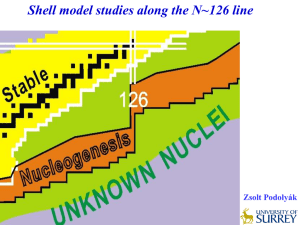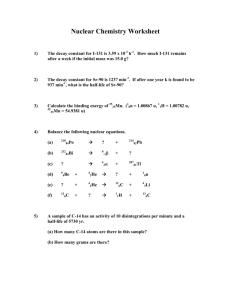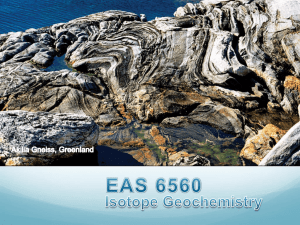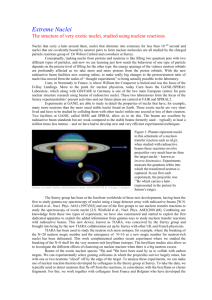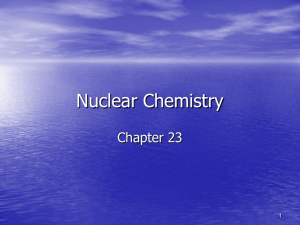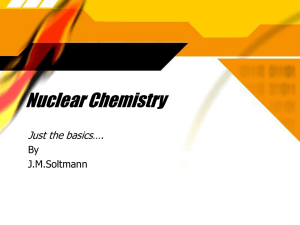Nuclear Decay and Stability
advertisement
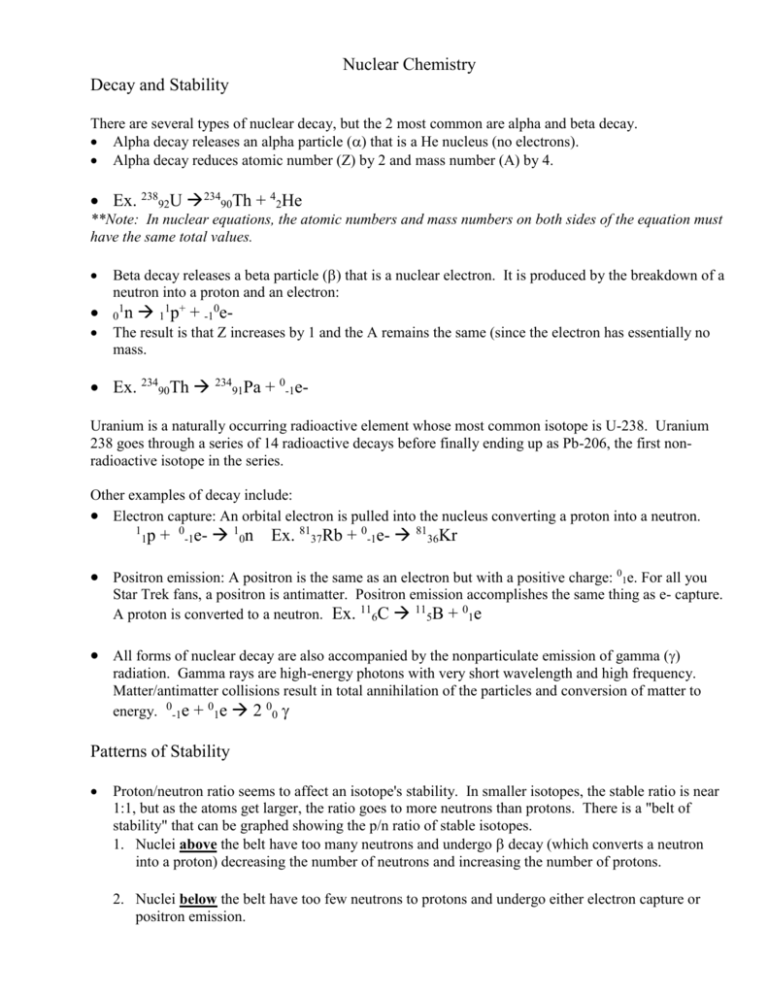
Nuclear Chemistry Decay and Stability There are several types of nuclear decay, but the 2 most common are alpha and beta decay. Alpha decay releases an alpha particle () that is a He nucleus (no electrons). Alpha decay reduces atomic number (Z) by 2 and mass number (A) by 4. Ex. 23892U 23490Th + 42He **Note: In nuclear equations, the atomic numbers and mass numbers on both sides of the equation must have the same total values. Beta decay releases a beta particle () that is a nuclear electron. It is produced by the breakdown of a neutron into a proton and an electron: 0 n 11p+ + -10e- 1 The result is that Z increases by 1 and the A remains the same (since the electron has essentially no mass. Ex. 23490Th 23491Pa + 0-1eUranium is a naturally occurring radioactive element whose most common isotope is U-238. Uranium 238 goes through a series of 14 radioactive decays before finally ending up as Pb-206, the first nonradioactive isotope in the series. Other examples of decay include: Electron capture: An orbital electron is pulled into the nucleus converting a proton into a neutron. 1 1p + 0 -1e- 10n Ex. 8137Rb + 0-1e- 8136Kr Positron emission: A positron is the same as an electron but with a positive charge: 01e. For all you Star Trek fans, a positron is antimatter. Positron emission accomplishes the same thing as e- capture. A proton is converted to a neutron. Ex. 116C 115B + 01e All forms of nuclear decay are also accompanied by the nonparticulate emission of gamma () radiation. Gamma rays are high-energy photons with very short wavelength and high frequency. Matter/antimatter collisions result in total annihilation of the particles and conversion of matter to energy. 0-1e + 01e 2 00 Patterns of Stability Proton/neutron ratio seems to affect an isotope's stability. In smaller isotopes, the stable ratio is near 1:1, but as the atoms get larger, the ratio goes to more neutrons than protons. There is a "belt of stability" that can be graphed showing the p/n ratio of stable isotopes. 1. Nuclei above the belt have too many neutrons and undergo decay (which converts a neutron into a proton) decreasing the number of neutrons and increasing the number of protons. 2. Nuclei below the belt have too few neutrons to protons and undergo either electron capture or positron emission. 3. Nuclei with atomic number Z 84 are all radioactive and tend to undergo decay. 4. Magic numbers: For some unknown reason, nuclei with 2, 8, 20, 28 50 or 82 protons or 2, 8, 20, 28 50 or 82 and 126 neutrons are more stable than other nuclei that do not contain these numbers of nucleons. 5. Nuclei with even numbers of protons and/or neutrons tend to be more stable than those with odd numbers. Those with even numbers of both protons and neutrons are more stable than other nuclei. Nuclear Transmutation: This nuclear change occurs when a nucleus is struck by another particle or nucleus, such as a neutron or particle. Ex. 35 17Cl + 10n 3516S + 11H Half Life Half-life is the time required for 1/2 of the atoms in a radioactive sample to decay into another element. Ex. 9038Sr 9039Y + 0-1e t1/2 = 29 yrs. If the original sample is 10g, in 29 years, 5g will still be Sr-90. In 58 years, only 2.5g remain. Another 29 yr. later, 1.25g of Sr-90 remain, etc. These nuclear half-life follow the 1st order kinetics rules where k = 0.693/ t1/2 and may range from a fraction of a second to several billion years. Half-life is useful in dating different types of objects. One of the most well known forms is C-14 or radiocarbon dating. C-14 is a radioactive isotope of carbon formed in the atmosphere when N-14 is struck by a neutron and undergoes nuclear transmutation to C-14. The amount of C-14 in the environment is pretty much constant, and so the amount that is incorporated into living systems is also constant, as long as the organism is alive. When it dies, the C-14 continues to decay, but no new C-14 is taken in. By using a detector and determining how much C-14 is left in the once living tissue (cloth, wood, bone, etc.) scientists can determine about how old the organic material is. C-14 has a half-life of 5,700 years. The following calculation can be done using k = rate constant. For C-14, k = 1.2 x 10-4 yr-1. lnNt/N0 = -kt Where Nt is the number of radioactive nuclei remaining at time t and N0 is the original number of nuclei at t = 0. This method has been used to date many artifacts including the fabled Shroud of Turin. The debate surrounding the shroud continues. Originally, scientists using C-14 dating placed the shroud at only 600740 years old. However, others argue that dust and mildew that has collected on the linen since it was woven can significantly distort the dating process and that the cloth may indeed be well older than dating would indicate. C-14 dating can only date organic objects that are 20,000- about 50,000 years old and that have not fossilized. Dating can be used with other elements as well. For example the Pb-206/U-238 content of rocks can be used to date the rocks. Ex. A rock contains 0.257mg of Pb-206 for every 1.000mg of U-238. The t1/2 of U-238 is 4.5 x 109 yr. How old is the rock? Nt = 1.000mg. We can calculate the original amount of U-238 by looking at the amount of lead into which the original uranium has decayed. For every 238mg of original U-238, there are now 206mg of Pb-206, so: 0.257mg Pb-206 x (238mg U-238/206mg Pb-206) = 0.297mg U-238 Originally there were 1.000mg + 0.297mg = 1.297mg U-238 = N0. k = 0.693/(4.5 x 109 yr.) = 1.5 x 10-10 yr-1 Rearranging the equation above: t = (-1/k)ln(Nt/N0) = -1/(1.5 x 10-10 yr-1) ln(1.000/1.297) = 1.7 x 109 yr. Fission and Fusion Large, unstable nuclei can undergo fission as well as the other types of decay mentioned. Ex. 23592U + 10n 14256Ba + 9136Kr + 3 10n 1. 2. 3. 4. If there is a sufficient number of such fissionable nuclei around, so that the neutrons released by the fission above strike and destabilize other nuclei, a chain reaction can begin. This is how nuclear reactors for power plants and submarines work. If critical mass is present and the chain reaction is uncontrolled, an atomic explosion can result. Ex. The bombs dropped on Japan at the end of WW II. In nuclear reactors, control rods may be pushed in or pulled out to slow or speed up the reaction. The heat generated is used to convert water to steam for power. Nuclear fusion is the reaction that occurs in stars including our sun. + 11H 21H + 01e 1 2 3 1H + 1H 2He 3 3 4 1 2He + 2He 2He + 2 1H 3 1 4 0 2He + 1H 2He + 1e 1 1H Hydrogen nuclei are fused into helium nuclei at temperatures of about 40,000,000 K. At these temperatures, physical containment of fusion reactions becomes difficult. A device called a tokamak generates a strong electromagnetic field which can act as a "plasma bottle" to contain the reaction. However, at this time, nuclear fusion while a very desirable source of energy, is not practical. The SI unit of radioactivity is the becquerel 1 nuclear disintegration/sec. The curie (Ci) is also used 3.7 x 1010 disintegrations/sec. Often radiation is measured in millicuries or microcuries. 1 rad (radiation absorbed dose) = 1 x 10-2J/kg of body tissue RBE (relative biological effectiveness) = a constant based on the type of radiation being received (alpha, beta, gamma) Roentgen equivalent for man (rem) = number of rads x RBE. An exposure of 600 rem is fatal to most humans. A dental X-ray exposes you to about 0.5 mrem. The Chernobyl accident released a total of 50-100 MCi. The firefighters and plant workers all received > 100 rem of radiation and most if not all died.


